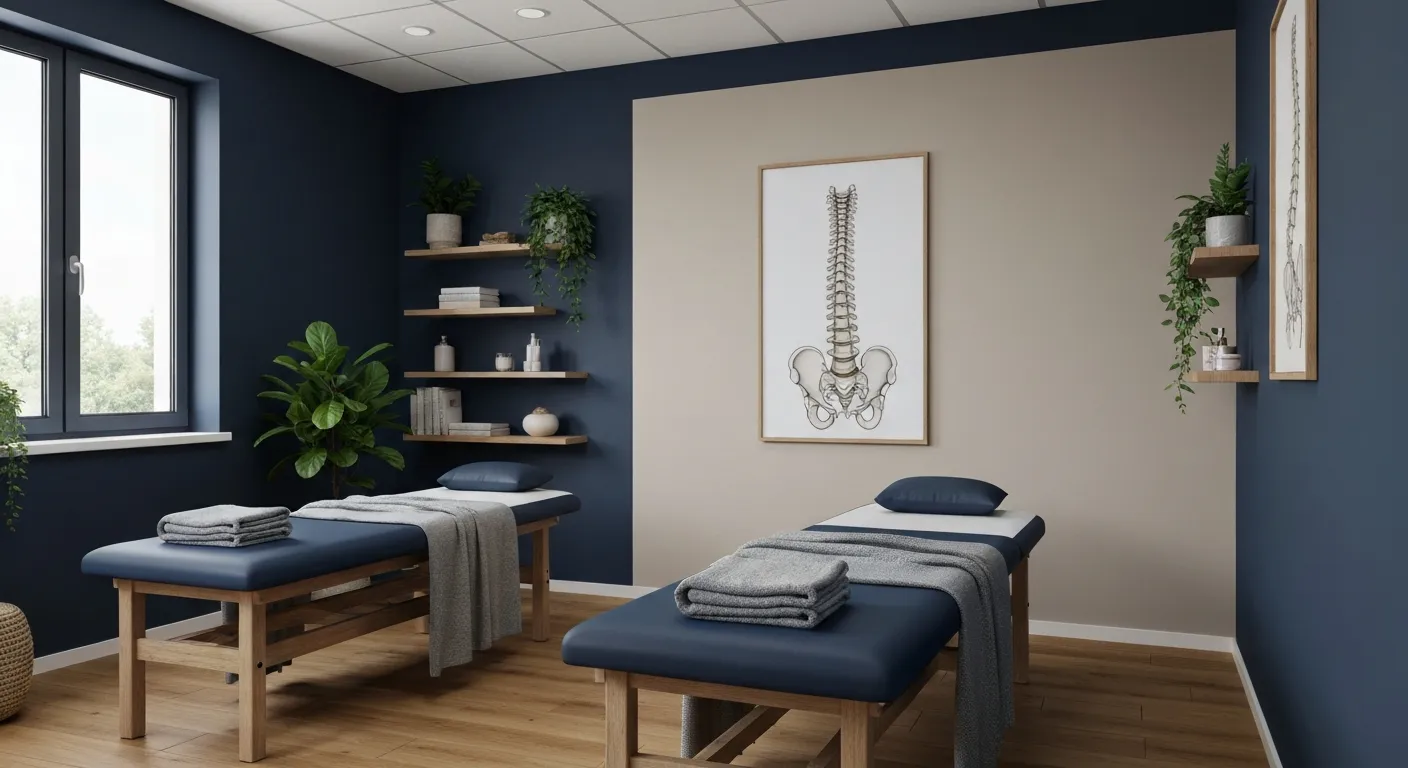Benefits of Regular Chiropractic Care for a Stronger Back
November 4, 2025
7 min

The Foundation for a Healthier Back
A strong, well-aligned back is vital for overall mobility, pain-free living, and long-term wellness. Modern lifestyles often impose stresses—prolonged sitting, poor posture, injury, and muscle imbalances—that can weaken the spine and contribute to chronic discomfort. Regular chiropractic care offers a holistic, drug-free approach that targets the root causes of back issues by realigning the spine and improving musculoskeletal health, helping patients maintain strength, flexibility, and function over time.
What Is a Chiropractic Adjustment and How Does It Benefit Back Health?

What is a chiropractic adjustment?
A chiropractic adjustment, also known as spinal manipulation, is a specialized therapeutic treatment delivered by a licensed chiropractor. It involves applying controlled, precise force to a specific spinal joint to realign the spine and improve its mobility. During the procedure, patients often lie face down while the chiropractor uses their hands or small instruments to perform the adjustment. A characteristic popping or cracking sound may occur, caused by the release of gas from the joints (popping sound).
How do chiropractic adjustments benefit back health?
These manipulations work by relieving pressure on nerves, reducing muscle tension, and restoring proper spinal alignment. This can decrease inflammation and improve overall spinal function. By correcting misalignments, chiropractic adjustments support the body's natural healing processes, enhancing nerve signaling and movement efficiency.
Immediate and long-term effects on back health
Many patients experience immediate relief from pain and increased range of motion after an adjustment. Minor soreness or aching that may follow typically resolves within 24 hours (post-treatment soreness. Over time, regular chiropractic care aims to maintain spinal health, prevent future misalignments, reduce chronic pain episodes, and promote better posture and physical function.
Conditions treated with chiropractic care
Chiropractic adjustments are widely used to manage various musculoskeletal issues, including lower back pain, neck pain, headaches (such as migraines and tension headaches), muscle aches, sciatica, osteoarthritis symptoms, and minor injuries like whiplash. Treatment plans often include complementary therapies such as soft tissue work, therapeutic exercises, and ergonomic advice to support spinal health.
The Science-Backed Effectiveness of Chiropractic Care for Low Back Pain

Is chiropractic care effective for low back pain?
Multiple high-quality studies, including randomized controlled trials and systematic reviews, confirm that spinal manipulation provided by chiropractors effectively helps relieve acute, subacute, and chronic low back pain. Patients often experience moderate pain reduction and improved physical function following treatment, making chiropractic care a well-supported option for managing low back discomfort.
How does chiropractic care compare to medications and surgery?
Chiropractic care offers a non-invasive, drug-free alternative for back pain management. It is typically recommended before considering invasive treatments such as injections or surgery. Importantly, chiropractic treatments can reduce dependence on opioid pain relievers and have shown comparable or superior effectiveness in easing non-specific neck and back pain. Additionally, chiropractic care is linked to lower overall healthcare costs compared to more invasive interventions.
What are the safety considerations and risks?
When delivered by licensed and trained chiropractors, spinal adjustments are generally safe. Minor and temporary side effects, such as soreness or fatigue, may occur but usually resolve quickly. Serious complications like herniated discs, nerve irritation, or strokes are very rare and are mostly tied to improper technique or care by unqualified providers. Screening and proper patient evaluation help minimize these risks, ensuring safe care delivery.
In summary, chiropractic care for low back pain stands on strong scientific evidence for effectiveness and safety, presenting a valuable treatment path that avoids medication side effects and surgical risks while promoting functional recovery.
How Regular Chiropractic Care Supports a Stronger, More Flexible Back

How does chiropractic care improve back strength and flexibility?
Regular chiropractic adjustments play a crucial role in enhancing back strength and flexibility. By correcting spinal misalignments and subluxations, chiropractic care helps reduce stiffness and muscle tension around the joints. This realignment promotes improved joint mobility and a greater range of motion, allowing the spine and surrounding muscles to move more freely and efficiently. Patients often experience less pain and an easier time performing daily activities, as well as improved physical performance.
Can chiropractic care help with posture and prevent future back problems?
Absolutely. Poor posture, often caused by prolonged sitting, extensive screen time, or repetitive strain, can lead to back problems over time. Chiropractic care addresses these issues by restoring proper spinal alignment, which reduces muscle imbalances and nerve irritation. This results in better posture and a decreased likelihood of developing chronic musculoskeletal conditions. Preventive chiropractic treatments can detect and correct minor misalignments early, helping to avert injuries and support long-term spinal health.
Additional Benefits: Injury Prevention and Long-Term Musculoskeletal Health
Regular chiropractic visits not only improve immediate pain and mobility but also strengthen the overall musculoskeletal system. Proper spinal alignment and joint function reduce the risk of injuries by lessening undue strain on muscles and ligaments. Over time, consistent care helps maintain spinal integrity, lowers inflammation, and supports nerve function, leading to sustained musculoskeletal health and improved quality of life for patients at all ages.
Complementary Techniques and Lifestyle Advice to Maximize Back Health

What other treatments might chiropractors include with adjustments?
Chiropractors often complement chiropractic adjustment with additional therapies designed to enhance healing and reduce discomfort. These include massage, trigger point therapy, and myofascial release to alleviate muscle tension and stiffness. Spinal decompression therapy gently stretches the spine to relieve pressure on discs and nerves, aiding recovery from herniated discs or stenosis. Laser therapy, particularly Class 4 Deep Tissue Laser, promotes tissue repair by boosting cellular activity and improving circulation. Instrument-assisted techniques like the Activator Method provide precise, gentle adjustments for patients sensitive to manual manipulation.
How does chiropractic care integrate exercises and lifestyle guidance?
Exercise and lifestyle play a pivotal role in maintaining back health alongside chiropractic adjustment. Chiropractors often prescribe postural correction exercises to combat issues like "text neck" and poor posture due to prolonged sitting. Core strengthening, gentle stretching, and low-impact activities support spinal stability and flexibility. Patients also receive education on ergonomics and daily habits to minimize strain on the spine. Holistic care encompasses nutritional counseling and stress management, which contribute to overall musculoskeletal wellness and prolong treatment effects.
Through combining manual therapies and spinal manipulation with tailored exercises and lifestyle changes, chiropractic care addresses not only immediate pain relief but also the prevention of future back issues, fostering long-term musculoskeletal health.
Targeted Care for Specific Back Conditions and Special Populations

What types of back problems can chiropractic care treat?
Chiropractic care is highly effective in managing a wide range of back conditions. These include common issues such as lower back pain treatment and sciatica, as well as herniated discs and injuries to muscles and tendons. Additionally, chiropractors address neuropathy, osteoarthritis symptoms, sacroiliac joint pain, and scoliosis. Beyond the spine, related problems like headaches and neck pain often improve with chiropractic treatment.
Is chiropractic care safe for arthritis and osteoporosis patients?
For individuals with arthritis, particularly osteoarthritis, chiropractic care offers gentle manipulations and adjunct therapies like ultrasound and low-level laser therapy to improve joint function and alleviate pain. However, patients with inflammatory arthritis or severe osteoporosis require tailored care with extra caution. Chiropractors carefully customize treatment plans to ensure safety and effectiveness for these conditions.
Can all ages benefit from chiropractic care?
Chiropractic treatments are suitable for patients across all age groups, including children and the elderly. Before treatment, practitioners conduct thorough screenings to determine the appropriateness of care based on age, health status, and specific medical conditions. This ensures safe, individualized therapies that meet the unique needs of each patient.
When is referral to specialists necessary?
In cases where more complex or severe conditions are present, such as fractures, tumors, or severe neurological symptoms, chiropractors may refer patients to medical specialists. Collaborating with other healthcare professionals ensures comprehensive management and optimal outcomes for patients requiring advanced care.
The Broader Health and Wellness Benefits of Regular Chiropractic Visits
How does chiropractic care affect overall health beyond back pain?
Proper spinal alignment achieved through chiropractic care improves nerve signaling and enhances the functioning of the nervous system. This optimization helps boost immune responses, reduce chronic inflammation, and supports the body's natural healing processes, contributing to overall health beyond just pain relief.
Can chiropractic care improve mood, sleep, and stress?
Yes. Patients frequently experience reduced nerve tension and alleviation of pain, which leads to lower stress levels. Improved nerve function may also enhance sleep quality, resulting in better mental well-being and mood stabilization.
Does chiropractic care benefit athletes?
Chiropractic adjustments are known to enhance joint mobility, reduce muscle soreness, and accelerate recovery time. These benefits support injury prevention and help athletes maintain or improve their performance effectively.
How does chiropractic care help reduce medication use?
By offering drug-free pain relief and improving physical function naturally, chiropractic care can decrease the need for opioid and other pain medication. This approach helps patients manage pain safely while minimizing potential medication side effects.
Building a Stronger Back with Chiropractic Care
Regular chiropractic care offers a scientifically supported, holistic approach to back health that goes beyond symptom relief. By realigning the spine, improving mobility, correcting posture, and integrating supportive therapies and lifestyle guidance, chiropractic care helps strengthen the back and prevent future problems. It provides a safe, non-invasive, and drug-free alternative that benefits people of all ages and supports overall wellness. Embracing chiropractic care as a proactive strategy can empower individuals to maintain an active, pain-free life with a resilient spine.
Recent articles

Inspiring Patient Testimonials Highlighting Chiropractic Success

Chiropractic Care: A Natural Solution for Back Pain Relief

Amazing Patient Success Stories in Chiropractic Wellness

Combining Physiotherapy and Chiropractic for Optimal Healing

Spinal Decompression Therapy: A Breakthrough for Sciatica Sufferers

5 Holistic Treatments That Complement Chiropractic Care

How Physiotherapy Supports and Enhances Chiropractic Treatment

Root Cause Versus Symptom Treatment: Making the Right Choice

7 Essential Things to Know Before Choosing Your Chiropractor

Why Addressing Root Causes of Pain Matters More Than Just Symptoms

Nutritional Counseling Strategies to Boost Your Overall Wellness

How Spinal Decompression Therapy Alleviates Sciatic Nerve Pain

Long-Term Pain Relief Through Targeted Corrective Exercises

10 Benefits of Integrating Physiotherapy with Chiropractic Treatments

Corrective Exercises That Help Prevent Recurring Pain

8 Corrective Exercises Proven for Lasting Pain Relief

Lifestyle Habits for Maintaining a Healthy Spine

What You Will Experience at Your Initial Chiropractic Visit

What Happens at Your First Visit to a Chiropractor?

Focusing on Root Cause Analysis for Effective Pain Relief

Tips for Lifestyle Changes to Support Spinal Health

Tips for Lifestyle Changes to Support Spinal Health

Holistic Treatment Plans: Alternatives to Surgery for Chronic Pain

Enhance Wellness Through Personalized Nutritional Counseling

Non-Invasive Pain Relief: Exploring Holistic Treatment Alternatives

Sciatica Relief Through Targeted Spinal Decompression

Integrating Physiotherapy with Chiropractic Treatments for Better Results

Testimonials That Demonstrate the Benefits of Chiropractic Care

The Power of Corrective Exercises in Pain Management

A Step-by-Step Guide to Your Initial Chiropractic Consultation

9 Nutritional Tips to Enhance Your Chiropractic Wellness Journey

Patient Experiences: How Chiropractic Care Changed Their Lives

Lifestyle Recommendations to Keep Your Spine in Top Shape

Effective Corrective Exercises for Long-Term Pain Relief

Back Pain Benefits: What Chiropractic Care Can Do for You

Spinal Decompression Techniques for Effective Sciatica Relief

Top Nutritional Counseling Tips for Enhanced Wellness

6 Lifestyle Habits That Boost Spine Health Daily

Discover Holistic and Non-Surgical Pain Relief Solutions

Exploring Holistic and Non-Surgical Treatment Options for Pain

The Role of Physiotherapy in Enhancing Chiropractic Care Outcomes

Complementing Chiropractic Care with Physiotherapy: What You Need to Know

What to Expect During Your First Chiropractic Visit

Simple Lifestyle Adjustments to Maintain a Healthy Spine

Personalized Nutritional Counseling for Improved Health Outcomes

Exploring Non-Surgical Treatments for Spine-Related Conditions

An Introduction to Spinal Decompression for Sciatica Patients

Transformative Success Stories: Patient Experiences with Chiropractic Treatments

Why Chiropractic Care Is Essential for Back Pain Relief

Addressing Underlying Causes Versus Symptom Management in Pain Care

The Role of Nutrition in Enhancing Chiropractic Treatment Effectiveness

Sciatica Treatment Options: Is Spinal Decompression Right for You?

Lifestyle Tips to Maintain a Healthy Spine and Prevent Back Issues

The Synergy Between Physiotherapy and Chiropractic Treatments

What Happens During Your Initial Chiropractic Consultation

Effective Corrective Exercises for Sustainable Pain Management

Taking a Root Cause Approach to Chronic Pain Management

Holistic Pain Management Techniques Without Surgery

How Patient Success Stories Validate Chiropractic Care Benefits

Spinal Decompression: Innovative Treatment for Sciatic Nerve Pain

Spinal Decompression Therapy: A Non-Invasive Approach to Sciatica Relief

Exploring Holistic Approaches Beyond Surgery for Pain Relief

Practical Lifestyle Advice to Support a Healthy Spine Every Day

Corrective Exercise Routines Designed for Long-Term Pain Prevention

Real Patient Stories: Overcoming Chronic Pain with Chiropractic Care

Lifestyle Changes That Promote a Healthy Spine and Prevent Injury

How Addressing the Root Cause of Pain Leads to Lasting Relief

Non-Surgical Holistic Therapies to Manage Chronic Pain Effectively

Nutritional Counseling's Impact on Physical Health and Healing

Benefits of Regular Chiropractic Care for a Stronger Back

Your First Chiropractic Visit: What to Expect and How to Prepare

Patient Experiences: How Chiropractic Care Transformed Their Lives

Exploring Holistic, Non-Surgical Options for Pain Management

Combining Physiotherapy with Chiropractic Treatments for Enhanced Recovery

Holistic Treatments That Offer Alternatives to Surgery for Pain Relief

Corrective Exercise Strategies for Long-Term Spine Health

How Physiotherapy Complements Chiropractic Adjustments for Better Outcomes

First-Time Chiropractic Visitors: What You Should Know

Understanding the Importance of Treating Pain at Its Source

Adopting Lifestyle Changes to Support Your Spine's Wellness

Utilizing Physiotherapy to Enhance Chiropractic Treatment Outcomes

The Key Advantages of Chiropractic Care for Back Pain Sufferers

Why Focusing on Root Causes Improves Pain Treatment Success

Corrective Exercises That Promote Lasting Pain Relief and Mobility

Sciatica Relief Through Targeted Spinal Decompression Techniques

Preparing for Your First Chiropractic Appointment with Confidence

Healthy Lifestyle Habits for Maintaining Spinal Alignment

Success Stories Highlighting Chiropractic's Role in Pain Recovery

Top Benefits of Chiropractic Care for Chronic Back Pain

Nutrition Tips to Boost Your Overall Wellness and Recovery

How Chiropractic Care Alleviates Back Pain Naturally

How Nutritional Counseling Supports Overall Wellness and Spine Health

Step-by-Step Guide to Your First Visit with a Chiropractor

Using Nutrition to Support Chiropractic and Overall Wellness

Integrating Physiotherapy in Your Chiropractic Healing Journey

Integrating Physiotherapy in Your Chiropractic Healing Journey

How Physiotherapy Complements Chiropractic Adjustments for Faster Healing

Lifestyle Tips for Maintaining a Healthy Spine and Preventing Back Pain

Heartwarming Patient Testimonials Highlighting Chiropractic Success

